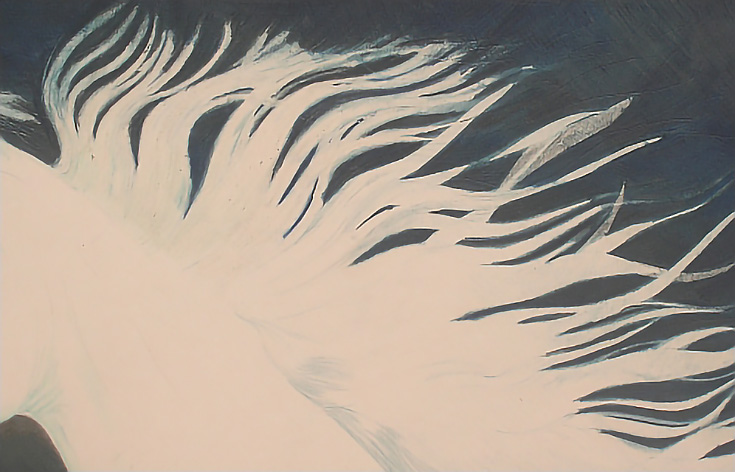Not every drawing is finished when you think it is. Sometimes, no matter how long you spend on a piece or how finished you make it, you come to realize that it could use a little more work. With some mediums it’s easy to add additional color. . . with colored pencil, not so much.
Below is a work-in-progress where I ran into this specific problem.

You can see there are many layers of color in the background that have been applied with heavy pressure. This contributed to a lot of wax buildup on the paper, but I still need to draw the horse’s mane over the background.
So what’s the best way to do that?
The first option, while simple, won’t always work—but here it is anyway:
Use blunt pencils and even heavier pressure
In the illustration below, I continued layering color over the background, but used increasing pressure with each color. For some of the darker colors (Black, Indigo Blue, Dark Brown) I had to use blunt pencils to avoid gouging or tearing the paper.

I kept my Cool Grey 20%, Powder Blue, and White pencils very sharp to add the highlights, but I still used medium-heavy to heavy pressure for each stroke and stroked in the direction of hair growth.
Unfortunately, the success of this technique is limited by your ability to apply enough pressure and additional layers to make new color stick to what is already on the paper.
In this drawing, the background simply had so much wax and pigment on the paper that it was impossible to get enough new color to stick in the way that I wanted.
So, I moved on to technique number two.
Restore tooth to your paper
If you want to do just a little bit of new work, the method above may be exactly what you need.
But for more extensive work, you have to restore the tooth of the paper so new color can stick to it. You could scuff the surface of the color already on the paper, but there’s a better—and safer!—method. It’s called workable fixative.
There are many brands of workable fixative available, so make sure to use a brand and type that’s suited to colored pencil work. I currently use Prismacolor Premier Fixative, in the matte version. Gloss is also acceptable but may not give you as much tooth to work with.
Step 1: Remove any “wax bloom”
When you have a lot of color on the paper, you are also likely to have something called wax bloom. Wax bloom happens when the wax binder rises to the surface of a drawing. The “bloom” makes a drawing look blurred or misty. It happens with all colors, but is especially noticeable on darker colors.
There was a lot of wax bloom on my demonstration drawing, so the first thing I had to do was remove it. Removal is a simple process: just wipe the drawing lightly with paper cloth or a clean, soft cloth. Use light pressure. One or two strokes should be sufficient.
Don’t be concerned if it you remove color, as well. You can see a little bit of color came off my drawing, and that’s okay. There will always be a small amount of pigment in the wax bloom, but if you use light pressure, you won’t remove enough color to damage the existing drawing.
Step 2: Mask off other areas of your drawing
Before you spray, make sure that only the area you want to work on is visible. In the illustration below, I used a couple of sheets of legal-sized paper to block off the rest of my drawing.
If the shape you’re working with is small or more complicated, cutting a mask to size and shape may be a better option.
Step 3: Apply the fixative
Spray the drawing with light layers of workable fixative, and let the surface dry completely between layers. I usually apply no less than two layers. . . if you’re working on a drawing-in-progress, you probably will not want to apply more than three layers.
You will want to remove the mask as soon as possible, so it doesn’t stick in the layer of workable fixative. Let the drawing air and dry completely.
NOTE: Make sure to work in an area that’s well ventilated. Wearing some type of respiratory protection is also a good idea.
Step 4: Add new layers of color
I used mostly the same colors as those in the background to create the darks in the horse’s mane. I kept the pencils fairly sharp, but because I was using heavy pressure, I didn’t sharpen pencils as often as I might otherwise have done. I began with Black and ended with Black, but added alternating layers of Indigo Blue and Dark Umber in between to get a deep, rich dark color that wasn’t flat.
Next, I used Cool Grey 20%, Powder Blue, and White with medium-heavy pressure and sharp pencils to add middle tones and highlights. This time, I kept the pencils very sharp. Again, I layered colors, adding light colors over dark colors to create a range of mid-tones and highlights.
Sometimes another layer or two of workable fixative will be necessary. If the fixative doesn’t restore enough tooth, try retouch varnish. You won’t be able to alter existing color once you use retouch varnish, but you will be able to add new color over it.
To sum up, if you’ve got a little workable fixative (or retouch varnish) it’s always possible to rework finished drawings—no matter how long the drawing has been finished, or how much wax buildup there is. And that’s a nice safety net to have.
This post may contain affiliate links.



